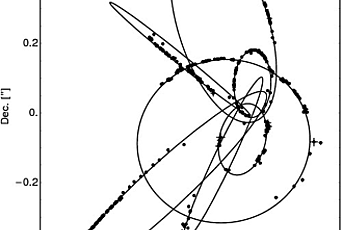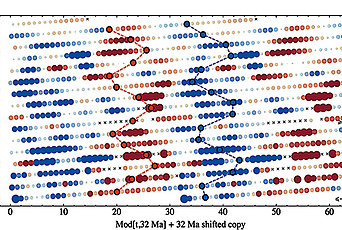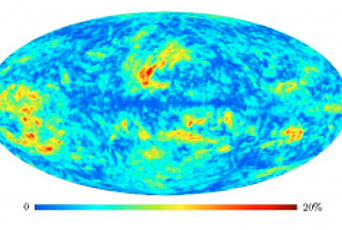The Latest News from the Cosmos
In the public lecture “The Latest News from the Cosmos,” Matias Zaldarriaga, Professor in the School of Natural Sciences, explores the most detailed map of the infant universe to date. Publicly released on March 21, 2013, the map shows relic radiation from the Big Bang, imprinted when the universe was just 380,000 years old. In this talk, Zaldarriaga reviews the new results and explains where they fit in our broader understanding of the beginnings and evolution of the universe. An article about his lecture appears below.
The most detailed map of the infant universe to date was publicly released in March, showing relic radiation from the Big Bang, imprinted when the universe was just 380,000 years old. This was the first release of cosmological data from the Planck satellite, a mission of the European Space Agency that was initiated in 1996 and involved hundreds of scientists in over thirteen countries. In a lecture in May, Matias Zaldarriaga, Professor in the School of Natural Sciences, explained how theoretical models allowed the Planck team to determine the composition of the universe, map the seeds for the formation of structure, and confirm our broad understanding of the beginnings and evolution of the universe.
Our current understanding of the history of the universe began to take shape around the 1930s, after Edwin Hubble discovered that the universe was expanding. Since then, there have been great advances in understanding the composition of the universe and how it has evolved through cosmic history. According to the standard cosmology model, in the current phase in the history of the Big Bang, the universe began about fourteen billion years ago. Initially the universe was hot and dense with interacting particles. It has been conjectured that prior to this phase, the universe underwent a brief period of accelerated expansion known as inflation when quantum fluctuations, stretched to cosmologically large scales, became the seeds of the universe’s stars and galaxies.
The Planck map—a composite made from nine maps of the sky in nine different frequencies by the Planck satellite—captures the early light from the cosmic microwave background radiation that is remnant from the Big Bang. The cosmic microwave background was first detected in 1964 and since then space, ground, and balloon-based experiments have mapped temperature variations of this light left over from the very early universe, allowing cosmologists to see if theoretical models can reproduce the formation of objects that can be seen through cosmic history. The Planck satellite is three times more sensitive than the previous satellite, the Wilkinson Microwave Anistropy Probe (WMAP), and its unprecedentedly precise map depicts “how the universe was before its structure had time to develop,” said Zaldarriaga. “We are seeing the initial conditions for this process of structure formation.”
According to the standard cosmology model and the latest Planck data, the universe is made up of ordinary visible matter (less than 5 percent), dark matter (about 27 percent), and dark energy (about 68 percent). Dark matter, which emits no light but exerts a gravitational pull, is believed to be a particle that was left over from the Big Bang. It has not yet been produced in a laboratory, such as the Large Hadron Collider, nor have detectors on Earth detected it, even though it is believed to pass through the planet. Even less is known about the mysterious dark energy, a uniform background field that is credited with accelerating the expansion of the universe.
Through the effect of gravitational lensing (the bending of light due to the presence of matter curving spacetime), Planck was able to map the distribution of dark matter in the universe, a method first proposed by Zaldarriaga and Uros Seljak in 1999. Through the Sunyaev-Zeldovich effect (named in part for Rashid Sunyaev, Maureen and John Hendricks Visiting Professor in the School of Natural Sciences, it identifies hot-gas regions through distortions in the cosmic microwave background radiation), Planck mapped the distribution of hot gas in the universe and discovered new clusters of galaxies.
In the 1980s, cosmologists developed inflation models of the very early universe that incorporated our current understanding of the laws of physics—the law of general relativity to understand how gravity works, and quantum mechanics to understand how matter behaves. To explain the universe’s longevity and homogeneity, theorists introduced a period of inflation before the Big Bang. Without it, a universe, behaving according to the laws of general relativity, would collapse into a black hole or become completely empty within a period of a few fractions of a second. Inflation had a surprise bonus: due to the uncertainty principles of quantum mechanics, inflation had to last longer in different regions. These tiny differences could then act as the seeds for structure.
According to inflation theory, as the universe expands exponentially fast, its geometry becomes flat —this geometry was confirmed experimentally around 2000. Theorists then had to use the laws of physics to solve the “graceful exit” problem of how to make the inflation stop so that the universe cools and structure starts to form. “In a sense, the material that filled the universe at the time of inflation had to act like a clock,” said Zaldarriaga. “The universe was expanding and at some point it had to stop this inflationary period to start something new.” Quantum mechanics then provides a source for fluctuations.
While Planck and WMAP have confirmed major details of inflation theory, in the coming months and years, cosmologists will try to explain some small anomalies in the Planck data, zero in on the correct prediction for identifying the physical system that stops the inflationary period, and develop better methods for detecting signatures of gravitational waves, which are believed to have been produced during inflation and could have shown up in the Planck data but haven’t yet.
Only more data, more observations, and more thinking will help cosmologists resolve what Zaldarriaga described as cosmology’s chicken (universe) and egg (inflation) problem, which leads to a range of possible solutions including the existence and collision of multiple chickens (and eggs) within the larger structure of a multiverse. “We have beautiful pictures of this chicken as it grows up,” said Zaldarriaga. “Of course the first question everybody asks is ‘Where does the chicken come from?’ Our theory friends in the ’80s came up with the idea that the chicken comes from an egg. If we say the chicken comes from an egg, where does the egg come from? It comes from a chicken. . . . Of course, we don’t know exactly what eggs should look like. The obvious thing to do is to try to get better pictures of the early universe, of some property of this egg that we can compute, and then see if it matches what we are now saying an egg might look like. This is how we can make progress, and this is what we are trying to do.”——Kelly Devine Thomas, Editorial Director


